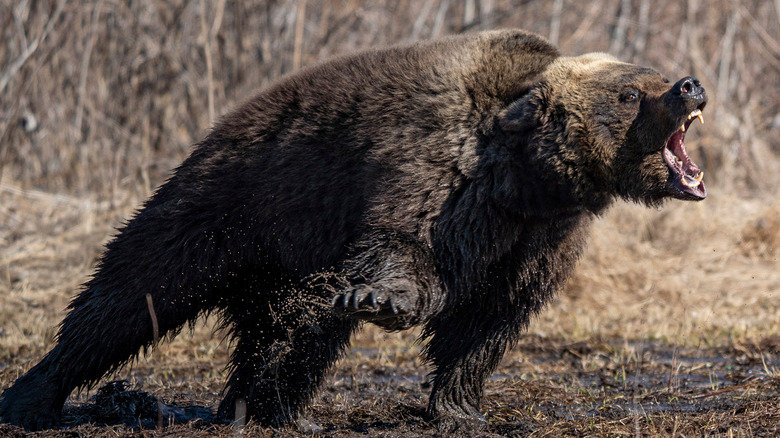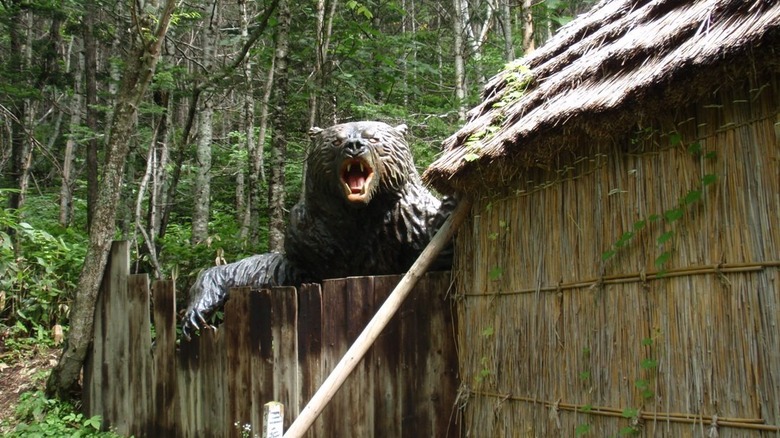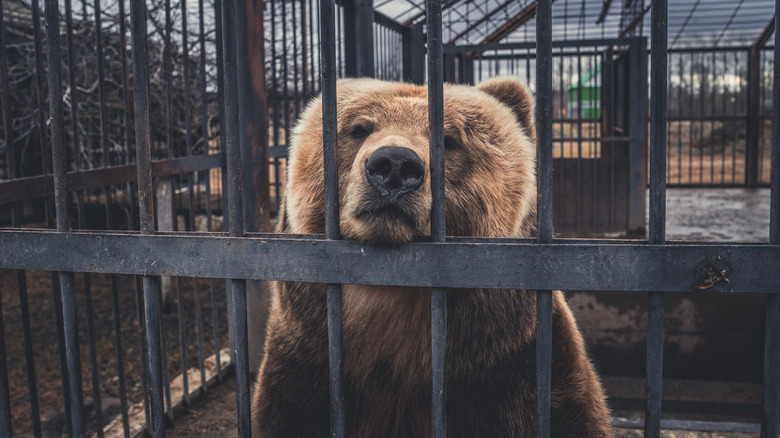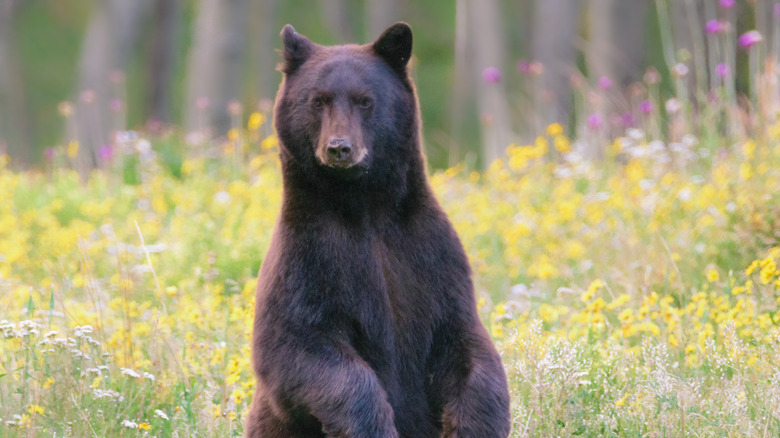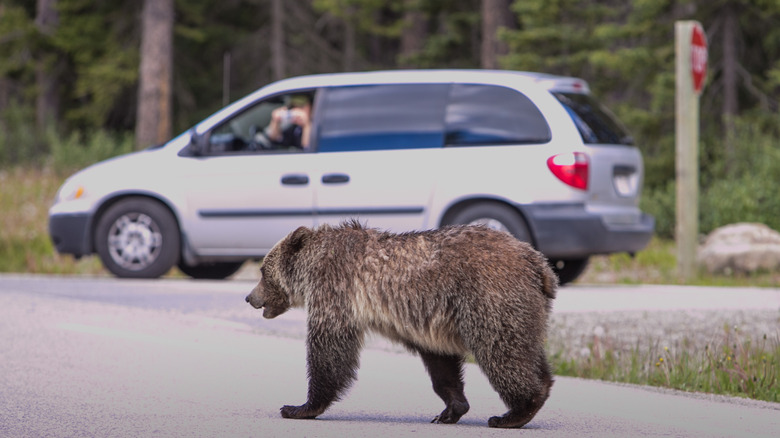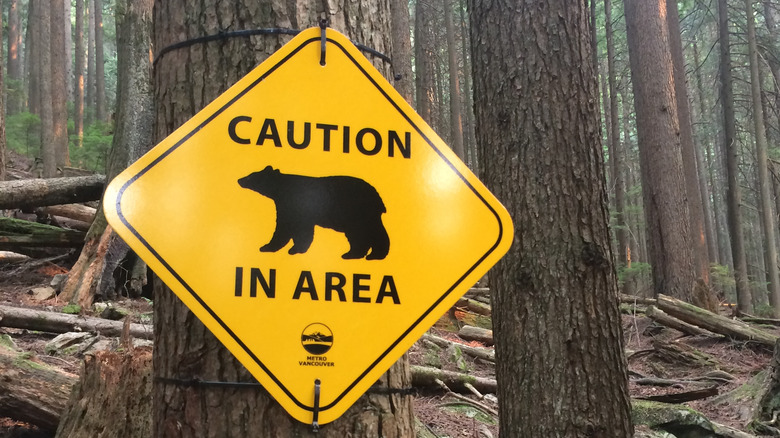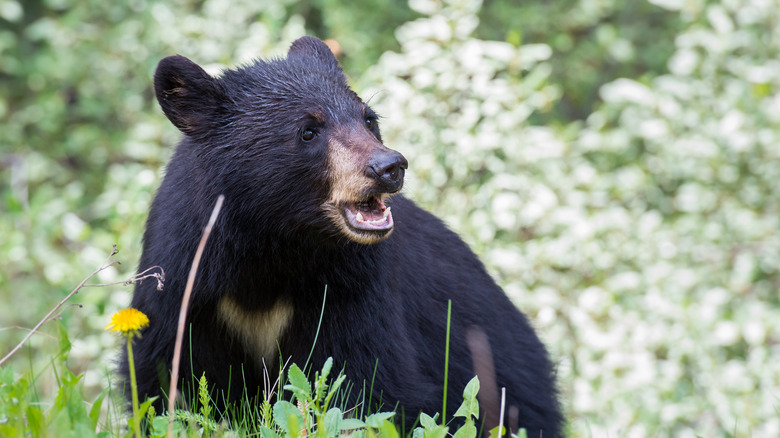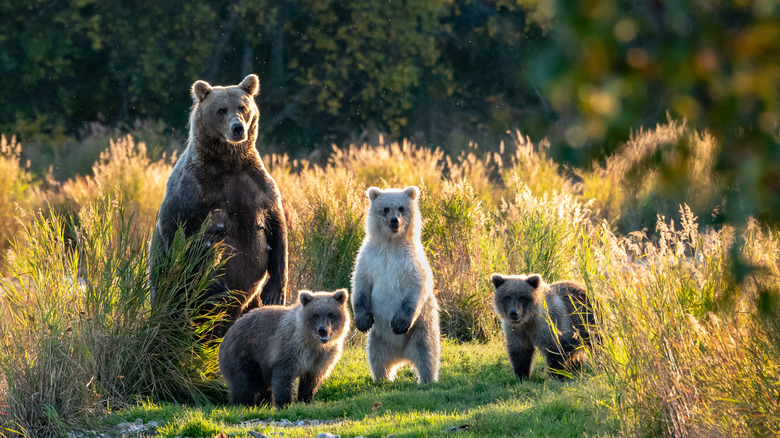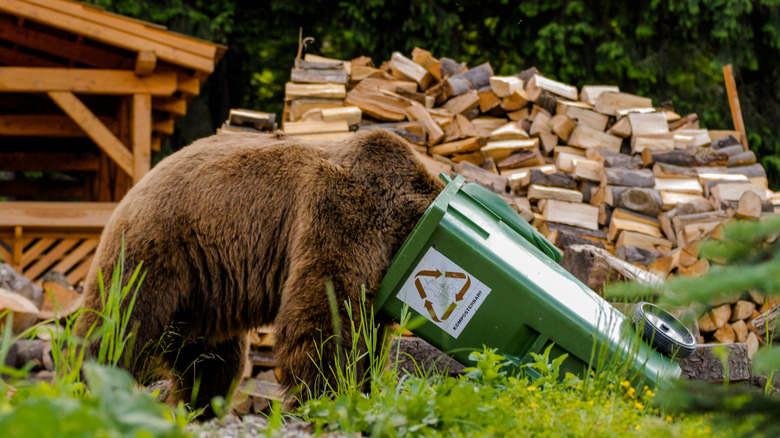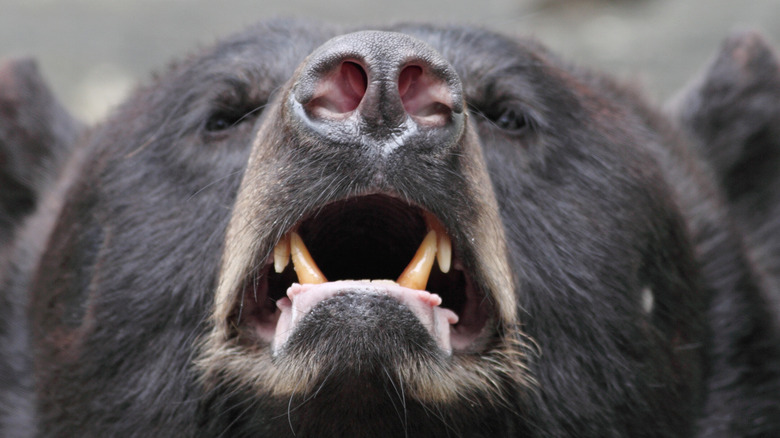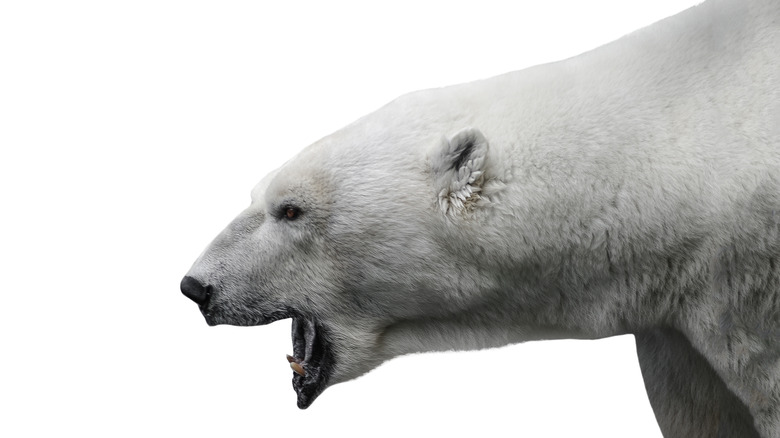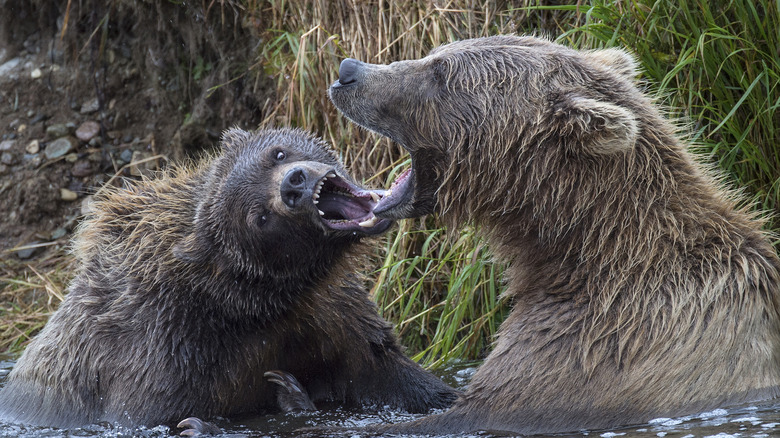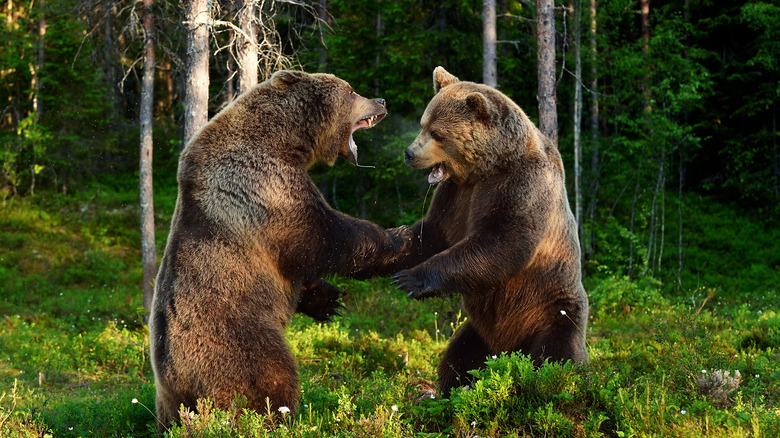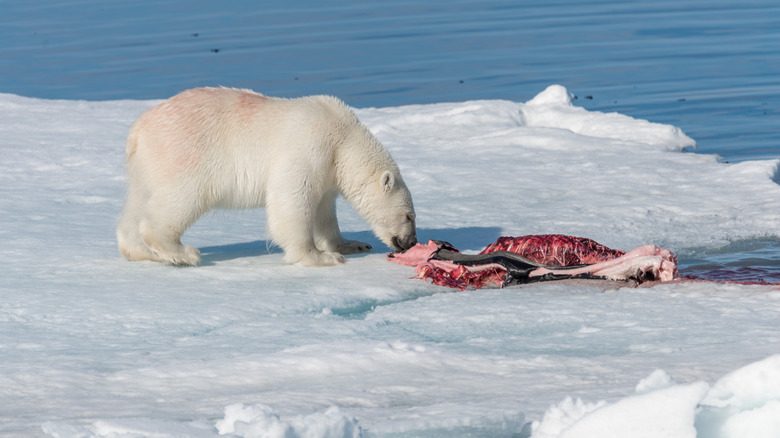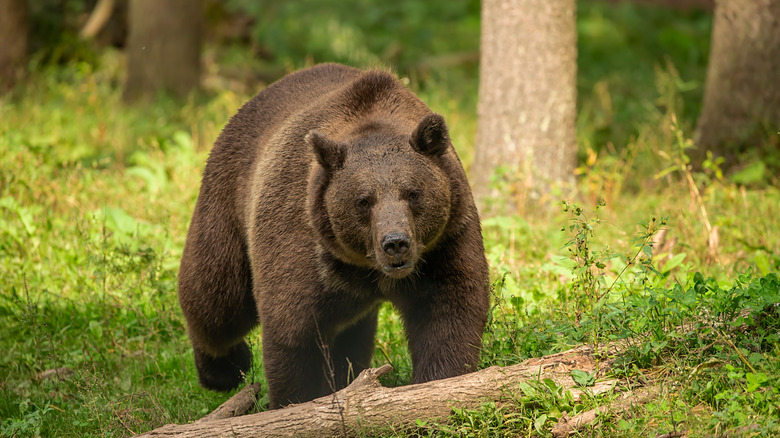The Deadliest Bear Attacks In History
Death by bear attack is a very rare way to go. Backpacker reported that in 2021 there were only five deaths by bear attack in North America. In fact, the article states it is more likely that you would die of a bee sting than by a bear mauling.
Yes, it is rare, but it also terrifying. Bill Bryson in "A Walk in the Woods" describes how he basically terrorized himself by reading the seminal work on the subject, "Bear Attacks: Their Causes and Avoidance." Bryson wrote (as excerpted on Lithub): "I lay saucer-eyed in bed reading clinically precise accounts of people gnawed pulpy in their sleeping bags, plucked whimpering from trees, even noiselessly stalked (I didn't know this happened!)" He added to that terror by considering all the different reasons that things could go horrifically wrong — a little too much hair gel, a misplaced candy bar, or maybe just plain old bad luck. And when those reasons led to someone staring down a bear, well, "bad luck" would be an understatement.
When you learn about of some the deadliest bear attacks in history, you also may want to just closet yourself into a highly urbanized area.
Hokkaido, Japan, 1915
When a bear attacks and kills one person, it is considered a tragedy. When two are killed, it is unfathomable horror. But just over a century ago, a brown bear in Japan killed seven people, possibly making it the worst series of bear attacks ever.
The island of Hokkaido is the northernmost of the main islands of Japan and has historically been the most wild. As summarized by "North American Predators," in December 1915, a brown bear entered the small village of Tomamae and over the course of days, went on a rampage. "Waiting for Wolves in Japan" tells us that the nearly 750-pound beast killed seven and injured three. This included children and one pregnant woman. A hunting party, organized like a military expedition, hunted down and killed the bear, which they nicknamed Kesgake, meaning "kesa-style slasher." The episode, called the "Sankebetsu Incident" or the "Tomamae Incident" sank its claws into Japanese popular notions of the brown bear as a menace to humans. In Tomamae, one can visit a monument and museum dedicated to the tragedy. Still, humans bore some responsibility in the cause of these exceptional attacks. Kesagake had been shot and injured before going on its deadly rampage. The bear was a wounded and compromised animal looking for food and not so much a demonic mankiller.
Cleveland Brookside Zoo, 1932
Imagine getting fired from your job. But what about if you not only got fired, but then on your way out the door, you got mauled to death?
That is exactly what happened to the unfortunate Thomas Earl, a zookeeper at the Cleveland Brookside Zoo. The New York Times reported that on July 8, 1932, Earl, for getting "kind of smart" had received his walking papers. He apparently was to finish his day, and one of his tasks was feeding a normally peaceable 900-pound Russian brown bear named Sunshine. Perhaps Earl had a bad attitude since he had just been sacked and Sunshine sensed it. Earl entered the pen to feed Sunshine a breakfast of carrots, bread, and raw meat and tried to force the bear into a concrete pit. Just then, the bear drew itself up, grabbed at Earl with one claw and raked him with the other. Another keeper, Edward Hagan, came running to help, but found that Earl had locked himself in. Hagan jabbed the bear with an iron bar through the bars to get it off the victim, but Sunshine just dragged a screaming Earl deeper into the enclosure. Other keepers batted at the bear with rakes but a conclusion only came as a law enforcement deputy fired five pistol shots into Sunshine. The bear dropped dead on top of Earl. The autopsy showed that Earl was shot twice, though he was already dead by the time the bear was killed.
Anchorage, Alaska, 1952
What if a bear mauled you, but nobody could hear you scream? This is what evidently happened to 50-year-old trapper Rudolph Gaier in the wilderness outside Anchorage, Alaska, in 1952. The Register-Guard reported that in December, his corpse was found in his cabin on his blood-soaked bed. A dead black bear laid close at hand. Investigators believed that what happened was an epic — albeit unseen — struggle.
In what would have been a nightmare, even for the most hardened of backwoodsmen, the black bear had broken into the cabin late at night. Gaier then threw a lantern at the animal and leapt out a window before shooting back through the door to kill the bear. He then looked inside to see if it was dead. Yet before the animal ultimately expired it made one last attack at Gaier, clawing him. The trapper then stumbled to his bed where he apparently bled to death.
Glacier National Park, Montana, 1967
The most impactful bear attack was the so-called "Night of the Grizzlies." As Smithsonian details, in the darkness of the early morning of August 13, 1967, grizzly bears attacked and killed two 19-year-old girls, Julie Helgeson and Michele Coons, at Glacier National Park in Montana in separate attacks. In both cases, the victims had been in sleeping bags and dragged off to be mauled to death.
This tragedy was in many ways caused by humans. Outside Online explains that until the incident, no grizzly had ever killed a human in the park. However, over the years, visitors would leave garbage about or even actively feed the bears. As a result, the animals lost their fear of humans. It was a short step toward making them a prey item. A popular book on the incident, "Night of the Grizzlies," predicted that the bruins would be eradicated from the lower 48 states. However, instead of eradication, parks tried to put into practice better bear management practices, including installing bear-poof garbage cans, separating cooking areas from sleeping areas, hanging steel cables to hang food, and installing strict practices to prohibit feeding and interacting with bears. Still, park rangers were averse to bears and in the years that followed, killed many more bears than what was necessary — by 1975, only 136 bears remained in Yellowstone. Since then, bears have come back and better practices have led to less bear attacks.
Glacier National Park, British Columbia, Canada, 1976
On July 25, 1976, naturalist Andy Stepniewski went on a day hike with his fiancée Barbara Chapman at Glacier National Park in British Columbia. According to the Vancouver Sun, the pair headed up on a trail to an area called Cougar Valley. Even though the trailhead was marked by signs warning about bears, the pair ignored it since almost every trail had warnings about bears. As they hiked, the pair made noise to alert bears; Chapman, for example, whistled.
Still, as they turned a corner they saw a mother grizzly bear with cubs charging right at them. The bear went for Stepniewski first, tearing off the top of his head, scalping him. After disabling him, the bear went for Chapman. She tried to fend it off by throwing her camera at it. That was the last Stepniewski saw of her as all went blank. He later stated, "I don't have a vision of her dying, and I'm thankful for that."
Stepniewski, injured, staggered a mile and half to the trailhead and a highway where a motorist rescued him. His injuries so damaged his brain that the right side of his body was rendered mainly useless, requiring extensive therapy. However, Stepniewski, nature lover that he was, remained a lifelong outdoorsman and became a notable naturalist after years of physical therapy to recover.
Algonquin Provincial Park, Ontario, Canada, 1978
On May 14, 1978, four boys, ages 12 to 18 were fishing in Algonquin Provincial Park in Ontario, Canada. According to "Bear Attacks: Their Causes and Avoidance," George Halfkenny had the best luck, having landed four trout which he carried in his pocket. Before leaving, he decided to try fishing again and went off by himself. Eventually, two of the other boys went to join him while the oldest, Richard Rindress, remained in the car to take a nap. By 6:30 p.m. none of the three had returned and Rindress could not locate them.
A search party went out locating the bodies of the three boys, and according to "Algonquin Wildlife," a 275-pound male black bear was found guarding the bodies. The bear was shot. Investigators determined that Halfkenny had been stalked and killed by the bear who then dragged off the body. At first, investigators thought that the bear may have been attracted to the trout in Halfkenny's pocket, but in fact the trout was found whole in the dead boy's pocket. The other two boys then — either in looking for Halfkenny or trying to rescue him — were also killed. What was most strange about this case was that the bear was perfectly healthy and had seemingly taken on predatory habits. While in most cases of bear attack human actions contribute to it in this case, it seems like the bear was just hungry.
Glacier National Park, Montana, 1987
There is nothing like being able to capture nature through photography, even if it is your last moments in life. Backpacker relates one such incident on April 25, 1987, when Charles Gibbs, an amateur wildlife photographer, was hiking at the Glacier National Park in Montana with his wife, Glenda. While on the way back to their car and clambering on the slopes of Elk Mountain, the pair spotted a grizzly sow with three cubs.
It goes almost without saying that anybody half familiar with bears knows how dangerous a mother grizzly is. The National Park Service states, "Never place yourself between a mother and her cub, and never attempt to approach them. The chances of an attack escalate greatly if she perceives you as a danger to her cubs."
Gibbs, entranced by the mother and cubs, told his wife to go ahead to the car while he went to photograph the bears. You can guess how this worked out. Gibbs was never seen alive again. However, there is a good notion of what happened as his camera was recovered and the photographs developed. He approached the bears and they tried to edge away. Finally, the last photo shows the mother bear at 50 yards ready to charge. According to UPI, Gibbs seemingly tried to escape by climbing a tree but was yanked down. The bears in this case were not eliminated since it was determined that the human was at fault.
King Cove, Alaska, 1992
Among the most terrible feelings in the human experience is the premature loss of a child. And the shock that must ensue, especially when it involves a wild animal, like a brown bear, must evoke an visceral primal response of grief. Such was the case, according to "Some Bears Kill," when on July 10, 1992, Lilian Bear (yes, that is her surname) was walking out of King Cove Alaska with her 3-year-old daughter and 6-year-old son, Antone. At one point, Antone noticed a large brown bear trailing them. Lilian then took her family over a guard rail and fled down a hill to escape. This triggered the animal's pursuit instinct. It ran after them and overtook Antone who became separated. At once, villagers came to the rescue and shot the bear. However, Antone was dead. It was determined that the bear was scavenging in the local dump, thus showing how human activity results in drawing bears into conflict with humans.
This incident, along with another bear attack fatality involving a black bear just two days before, resulted in escalated paranoia about bears in Alaska. According to the LA Times, this "bearanoia" resulted in people arming themselves and dishing out good money for bear spray.
Liard River Hot Springs Provincial Park, British Columbia, Canada, 1997
Normally, bears avoid humans, but in August 1997 at Liard River Hot Springs Provincial Park in British Columbia, there was an exception to this rule. The Washington Post reported that in this incident, Patti McConnell, a 37-year-old woman from Paris, Texas, was attacked by a black bear right in front of her two children. According to the Chicago Tribune, Kelly McConnell, the 13-year-old son, struck at the bear to save his mother. The bear in turn mauled him.
In fact, the bear turned and mauled McConnell's 13-year old son and a college student while tourists threw rocks and other objects at the animal to distract it. During the chaos, a British Columbia resident, 56-year-old Raymond Kitchen, attempted to save McConnell but was killed by the bear. The bear was finally killed by a tourist who, when the attack began, rushed to get a gun. However, it was too late, Patti McConnell was dead. Kelly received from the Canadian government a star of courage for his selfless, but ultimately vain, efforts. Raymond Kitchen too received the same decoration posthumously.
Nunavut, Canada, 1999
The polar bear of the Arctic is a highly dangerous animal. According to Britannica, aside from a single subspecies of grizzly bear, it is the largest land animal on the planet. It is also, unlike omnivorous black and brown bears, completely carnivorous. Its diet is primarily seals which it hunts out on the Arctic ice. In such a remote environment, it is not surprising that they have little to no fear of humans.
The problem is that as global temperatures rise and the natural habitat of the polar bear is melted away, it is forced onto land where it comes increasingly into conflict with humans. One example of this occurred in Canada's Arctic territory of Nunavut when, as reported by the Nunatsiaq News, a polar bear encountered and attacked a group of campers in July 1999. Two campers, a 66-year-old man and his 12-year-old grandson, were first attacked when they tried to retrieve their boat which drifted away during the night. The six-foot, 250-pound, year-and-a-half-old bear then made its way to camp where it generally mauled and created mayhem, injuring two. During the melee, the 64-year-old Hattie Amitnak was mauled to death while trying to come to the aid of her compatriots. Wildlife officers later found and killed the bear, noting that such an incident was a rare occurrence.
Katmai National Park, Alaska, 2003
There is no case of death-by-bear more famous (or infamous) than the death of Timothy Treadwell and his companion Amie Huguenard in 2003. Treadwell made a name for himself, as per IMDb as traveling to Alaska where he communed with very large grizzly bears. He became known as "Grizzly Man" and professed his love for these creatures which he promoted as harmless.
However, critics such as one writer from the High Country News argued that Treadwell harassed the grizzlies more than communed with them and that an attack was not just likely to happen, but inevitable. Just this occurred on October 6, 2003, when he and Amie Huguenard were at Katmai National Park. Treadwell was taken first, followed by Huguenard. What makes this attack so chilling is that his video camera recorded the audio of what occurred. As reported by the Chicago Tribune, this included the 46-year-old Treadwell shouting, "I'm being killed." He and Huguenard's remains were discovered after a pilot flying by saw what appeared to be a bear over a body. Park rangers found the site with an aggressive male brown bear standing over the bodies. They killed it. Both Treadwell and Huguenard were partially consumed. Treadwell's story makes for a great modern moral parable of how humanity should not underestimate or take nature for granted. The tape of Treadwell and Huguenard's last moments has never been released to the public.
Gallatin National Forest, Montana, 2010
Custer Gallatin National Forest in Montana contains three gateways to Yellowstone Park and has a rich biodiversity of North American fauna which includes –- yes, you guessed it — bears. On July 28, 2010, an unusual grizzly attack occurred due to its level of aggression. According to the Bozeman Daily Chronicle, in the middle of the night, a female grizzly silently attacked campers at the Soda Butte Campground. One woman, Deb Freele, was bitten in the arm while she slept. Screaming seemed to make the bear bite harder until she played dead and it left her alone. Another man, Ronald Singer, suffered lacerations. It was the 48-year-old Kevin Kammer of Grand Rapids, Michigan, a father of four according to mlive, who was pulled 25 feet out of his tent and mauled to death.
The next day, rangers managed to capture the female bear and two cubs using canister-like traps loaded with deer meat and also with scraps of the dead man's tent. There was nothing apparently wrong with the bear which would indicate why it would attack. In fact, the event seemed predatory. Park official Sam Shepart was quoted by the Bozeman Daily chronicle, saying, "She basically targeted the three people and went after them. It wasn't like an archery hunter who gets between a sow and her cubs and she responds to protect them."
Svalbard Archipelago, Norway, 2011
The Svalbard Archipelago is an Arctic territory of Norway with only one permanently inhabited island, Spitsbergen. Its pristine arctic ecosystem often attracts adventurers from abroad who want the thrill of a remote world where they might see exotic fauna such as polar bears. Be careful what you wish for.
Such was the case when, as reported by the Guardian, a group of British teens on an expedition under the auspices subset of the Royal Geographical Society visited Spitsbergen during the summer of 2011. While encamped, a polar bear managed to get by the tripwire defenses which were to set off flares to scare away any bears. The bear entered a tent and killed 17-year-old Horatio Chapple and injured four more before another member of the 13-person party shot the bear (although the rifleman was badly mauled while doing so).
One Spitsbergen resident commented, "The problem is when the ice goes, the bears lose their way and cannot catch food. People don't really know how dangerous they are — one came down to the sea recently and people were running down to take pictures. They had no idea their lives could be in danger."
Yukon, Canada, 2018
One of the most tragic bear fatality incidents occurred in the Yukon in November 2018. According to the CBC, Valérie Théorêt and her partner Gjermund Roesholt had gone to the Yukon to trap as a matter of a holiday with their 10-month-old daughter while she was on maternity leave. According to the later investigation, the mother and daughter had gone out for a walk while Roesholt was checking traplines. It was while they were walking that the mother and baby were ambushed by an emaciated 18-year-old grizzly who was looking for any food since it did not have enough fat reserves to hibernate. What is more, the grizzly had even eaten a porcupine to prevent starvation, which may have been causing it considerable pain. Théorêt and Roesholt were both good at acting proactively to not attract bears: no food was left out and the campsite was absolutely clean.
Sadly, the starving bear attacked and killed Théorêt and her daughter. Roesholt discovered the bodies at about 3:00 pm and shot the bear dead. Gordon Hitchcock, Yukon's chief conservation officer stated, "To say that the victims were in the wrong place at the wrong time sounds trite, but our investigation shows that more than anything else, this was an unfortunate tragedy and that little could have been done to prevent it."
